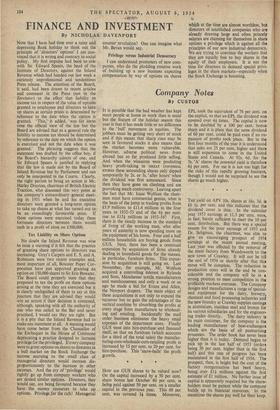Company Notes
By CUSTOS
IT is possible that the bad weather has kept more people at home or work than is usual but the feature of the holiday season this year is that it has made little or no difference to the 'bull' movement in equities. The jobbers must be getting very short of stock and if this means that sharp rises may be seen in favoured stocks it also means that the market becomes more vulnerable. However, adverse political news from abroad has so far produced little selling. And when the wiseacres were predicting heavy profit-taking in GREAT UNIVERSAL STORES these astounding shares only dipped temporarily by 2s. or 3s. 'after hours' when the dividend was first announced. Since then they have gone on climbing and are provoking much controversy. Leaving apart the fact that Mr. Isaac Wolfson the chair- man must have commercial genius, what is the basis of the jump in trading profits from £5.9 millions to £11.4 millions in the four years to 1952-53 and of the 41 per cent. rise to £151 millions in 1953-54? First, there is the steady increase in the standard of living of the working man, who after years of austerity is now spending more on the equipment of his home. Four and a half million households are buying goods from GUS. Next, there has been a continual expansion by acquisition of firms already dealing in household goods for the masses, in particular, furniture firms. This expan- sion by acquisition is still going on. Last November, for example, Mr. Wolfson acquired a controlling interest in Rylands and Sons, Manchester textile manufacturers and warehousemen and only a week or so ago he made a bid for Evans and Allen, the Newport drapers. The main object of these acquisitions is not only to expand the turnover but to gain the advantages of the vertical combine by absorbing the profits at every stage from manufacture to wholesal- ing and retailing. Incidentally the mail order business eliminates the heavy retail expenses of the department store. Finally GUS went into hire-purchase and financed itself, so that on furniture (which accounts for a third of the total sales) the manufac- turing-cum-wholesale-cum-retailing profit is increased by 15 per cent. to 20 per cent. for hire-purchase. This 'snow-balls' the profit growth.
How are GUS shares to be valued now? On the capital increased by a 50 per cent. share bonus last October 60 per cent. is being paid against 50 per cent. on a smaller capital in the previous year. This 60 per cent. was covered 31 times: Moreover,
EPL took the equivalent of 76 per cent, on the capital, so that ex-EPL the dividend was covered over 41 times. The capital is now to be doubled by a 100 per cent. bonus share and it is plain that the same dividend of 60 per cent. could be paid even if no ex- pansion of profits took place. But in the first four months of the year it is understood that sales are 25 per cent. higher and there is still expansion to come in the United States and Canada. At 92s. 6d. for the 5s. 'A' shares the potential yield is therefore 61 per cent. For me it is not too high for the risks of this rapidly growing business, though I would not be surprised to see the shares go much higher.
• • THE yield on APV 10s. shares at 16s. 3d. is £6 ls. per cent, and this indicates that the dividend cover is thin. In the calendar year 1953 earnings at 11.3 per cent. were, in fact, barely sufficient to meet the 10 per cent. distribution. But there was a special reason for the poor earnings of 1953 and Dr. Seligman, the chairman, was able to give an encouraging prospect of 1954 earnings at the recent annual meeting. Last year was affected by the removal of the main factory from Wandsworth to the new town of Crawley. It will not be till the end of 1954 or shortly after that this move will be complete. The reduction in production costs will in the end be con- siderable and the company will be in a strong position to meet competition in the profitable markets overseas. The Company designs and manufactures a range of special- ised equipment for the dairy, brewery, chemical and food processing industries and the new foundry at Crawley supplies castings in aluminium, stainless steel and bronze for its various subsidiaries and for the engineer- ing trades directly. The dairy industry is its main customer, for the company is the leading manufacturer of heat-exchangers which are the basis of all pasteurising processes. The order book has never been higher than it is today. Demand began to pick up in the last half of 1953 (orders being 50 per cent. higher than in the first half) and this rate of progress has been maintained in the first half of 1954. The prospect, then, is bright but the cost of the factory reorganisation has been heavy, being over £11 millions against the first estimate of £1 million. No further issue of capital is apparently required but the share- holders must be patient while the company builds up its financial resources. In the meantime the shares pay well for their keep.


































 Previous page
Previous page